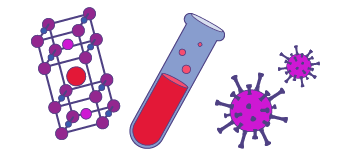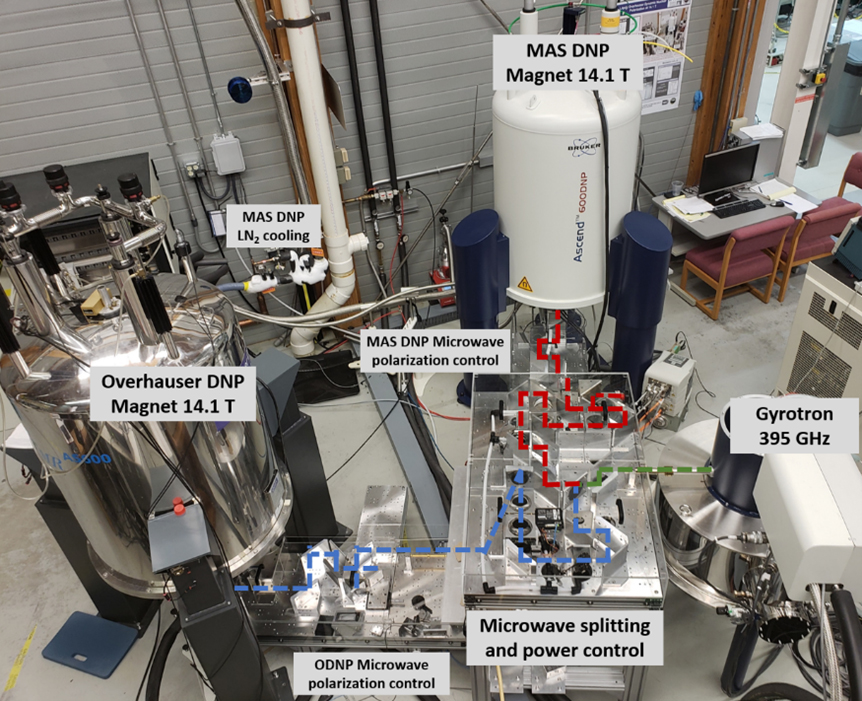DNP has been demonstrated to increase the sensitivity of NMR experiments by several orders of magnitude, which can lead to additional information about the systems being studied and drastically reduce experimental acquisition times.
In short, DNP uses microwave radiation to transfer the polarization from unpaired electron spins, present on stable radicals, to the nuclear spins of NMR active nuclei in molecules of interest. This increases the nuclear spins polarization leading to NMR spectra with very high signal to noise ratio. The time savings are tremendous and experiments that were impossible can now be carried out in matter of minutes to hours.
A solid-state MAS-DNP system operating at 14.1 T/395 GHz is available. Technology development for this spectrometer is performed through NIH-funded National Resource for Advanced NMR Technology. This instrument shares a gyrotron, the 395 GHz microwave source, with the in-house custom-designed solution NMR instrument.
The following spectrometer are available for this technique:

Explore our magnet schedule to see what exciting research is happening on our stellar fleet of instruments right now.

One gyrotron (395 GHz microwave source). Two 600 MHz DNP spectrometers: MAS-DNP user facility, liquid Overhauser DNP development instrument. The quasi-optical system allows the use of both DNP spectrometers simultaneously using a single gyrotron source.
Mentink-Vigier, F.; Eddy, S.; Gullion, T. MAS-DNP Enables NMR Studies of Insect Wings. Solid State Nucl. Magn. Reson. 2022, 101838. https://doi.org/10.1016/j.ssnmr.2022.101838.
Kirui, A.; Zhao, W.; Deligey, F.; Yang, H.; Kang, X.; Mentink-Vigier, F.; Wang, T. Carbohydrate-Aromatic Interface and Molecular Architecture of Lignocellulose. Nat. Commun. 2022, 13 (1), 538. https://doi.org/10.1038/s41467-022-28165-3.
Holmes, J. B.; Liu, V.; Caulkins, B. G.; Hilario, E.; Ghosh, R. K.; Drago, V. N.; Young, R. P.; Romero, J. A.; Gill, A. D.; Bogie, P. M.; Paulino, J.; Wang, X.; Riviere, G.; Bosken, Y. K.; Struppe, J.; Hassan, A.; Guidoulianov, J.; Perrone, B.; Mentink-Vigier, F.; Chang, C. A.; Long, J. R.; Hooley, R. J.; Mueser, T. C.; Dunn, M. F.; Mueller, L. J. Imaging Active Site Chemistry and Protonation States: NMR Crystallography of the Tryptophan Synthase α-Aminoacrylate Intermediate. Proc. Natl. Acad. Sci. 2022, 119 (2), e2109235119. https://doi.org/10.1073/pnas.2109235119.
Kang, X.; Kirui, A.; Muszyński, A.; Widanage, M. C. D.; Chen, A.; Azadi, P.; Wang, P.; Mentink-Vigier, F.; Wang, T. Molecular Architecture of Fungal Cell Walls Revealed by Solid-State NMR. Nat. Commun. 2018, 9 (1), 2747. https://doi.org/10.1038/s41467-018-05199-0.
Lilly Thankamony, A. S.; Wittmann, J. J.; Kaushik, M.; Corzilius, B. Dynamic Nuclear Polarization for Sensitivity Enhancement in Modern Solid-State NMR. Prog. Nucl. Magn. Reson. Spectrosc. 2017, 102–103, 120–195. https://doi.org/10.1016/j.pnmrs.2017.06.002.
Rankin, A. G. M.; Trébosc, J.; Pourpoint, F.; Amoureux, J. P.; Lafon, O. Recent Developments in MAS DNP-NMR of Materials. Solid State Nucl. Magn. Reson. 2019, 101 (May), 116–143. https://doi.org/10.1016/j.ssnmr.2019.05.009.
Last modified on 23 August 2024